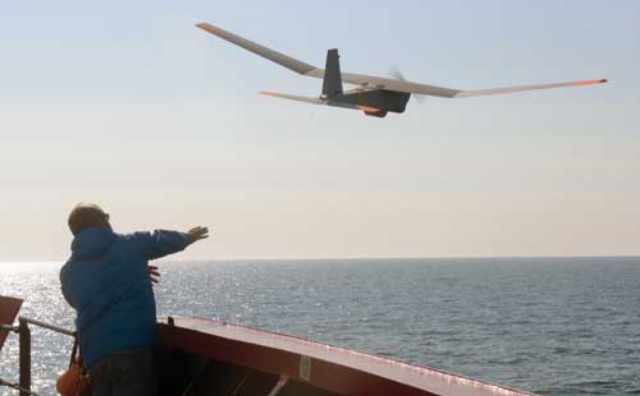 The National Oceanic and Atmospheric Association and the Coast Guard are teaming up in the Arctic to test new unmanned aerial system applications.
The National Oceanic and Atmospheric Association and the Coast Guard are teaming up in the Arctic to test new unmanned aerial system applications.
This summer, the Healy, the Coast Guard’s research icebreaker, conducted unmanned aerial vehicle tests in the Arctic alongside NOAA, said Robbie Hood, UAS program director at the scientific agency. The Coast Guard is “letting this ship be a testing ground for unmanned technologies, both water vehicles and air vehicles,” she said during the Association for Unmanned Vehicle Systems International’s annual program review.
NOAA used 13–pound Puma UAVs during the exercise. The system is built by AeroVironment, a Monrovia, California-based UAV manufacturer.
One experiment conducted during Arctic Shield included a simulated oil spill, Hood said.
“There is going to be increased … oil drilling in the Arctic. What would happen if there is an oil spill or some catastrophe? We all know how hard it was to address the problems in Deepwater Horizon. It’s going to be even worse in the Arctic,” Hood said.
To mimic an oil spill — such as the Deepwater Horizon catastrophe, where an estimated 5 million barrels of oil spilled into the Gulf Mexico in 2010 — scientists threw oranges, peat moss and environmentally safe green dye into the Arctic Ocean. Researchers then flew Pumas above the simulated spill to monitor it.
“One thing that is helpful about this is just being able to look at that image and see ‘how big is this oil spill? How big is it going to be?’” Hood said.
NOAA also worked with AeroVironment to test new landing methods for the aircraft, Hood said.
“The Puma was designed to land in the water. But it’s pretty dangerous to put a team over the side of the ship and either walk across the ice or go on a small boat to pick up the aircraft, so the Coast Guard was really interested in developing a different capture system for it,” Hood said.
Two new capture systems were demonstrated, Hood said. One included landing the Puma on the deck of the ship, but that was “a little rough on the aircraft,” she said. A net capture system was also tested.
Observing the Arctic will be critical going forward, Hood said.
“Polar monitoring is really important. You’re going to be hearing more and more and more about this in the years going forward because there’s a lot of change happening to the Arctic sea ice,” Hood said. “There is a concern that 10 years from now, 15 years from now, 20 years from now, that in the summer time the sea ice may melt so much that it will be completely ice free. That changes the whole dynamic of what’s happening in the Arctic.”
NOAA — which works with a number of unmanned systems, including the Global Hawk — wants to field additional UAVs, but any aircraft purchased would need to balance affordability, dependability and capability, Hood noted.
Source: National Defense
